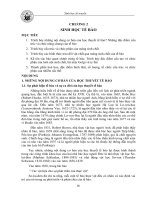Tin học ứng dụng trong công nghệ hóa học Parallelprocessing 9 scheduling
Bạn đang xem bản rút gọn của tài liệu. Xem và tải ngay bản đầy đủ của tài liệu tại đây (722.71 KB, 27 trang )
Parallel Job Schedulings
Thoai Nam
Scheduling on UMA
Multiprocessors
Schedule:
allocation of tasks to processors
Dynamic scheduling
– A single queue of ready processes
– A physical processor accesses the queue to run the next
process
– The binding of processes to processors is not tight
Static scheduling
– Only one process per processor
– Speedup can be predicted
Khoa Công Nghệ Thông Tin – Đại Học Baùch Khoa Tp.HCM
Classes of scheduling
Static scheduling
– An application is modeled as an directed acyclic graph (DAG)
– The system is modeled as a set of homogeneous processors
– An optimal schedule: NP-complete
Scheduling in the runtime system
– Multithreads: functions for thread creation, synchronization, and
termination
– Parallelizing compilers: parallelism from the loops of the sequential
programs
Scheduling in the OS
– Multiple programs must co-exist in the same system
Administrative scheduling
Khoa Công Nghệ Thông Tin – Đại Học Bách Khoa Tp.HCM
Deterministic model
A parallel program is a
collection of tasks, some
of which must be
completed before others
begin
Deterministic model:
The execution time needed
by each task and the
precedence relations
between tasks are fixed
and known before run time
T1
-------2
T4
-------2
T2
------3
T3
-------1
T6
-------3
T5
-------3
Task graph
Khoa Công Nghệ Thông Tin – Đại Học Bách Khoa Tp.HCM
T7
-------1
Gantt chart
Processors
Gantt chart indicates the time each task
spends in execution, as well as the
processor on which it executes
T4
T3
1
T2
2
3
T5
4
5
Time
T4
-------2
T2
------3
T6
T1
T1
-------2
6
T3
-------1
T7
7
8
9
T6
-------3
T5
-------3
T7
-------1
Khoa Công Nghệ Thông Tin – Đại Học Bách Khoa Tp.HCM
Optimal schedule
If all of the tasks take unit time, and the task graph is a
forest (i.e., no task has more than one predecessor), then a
polynomial time algorithm exists to find an optimal schedule
If all of the tasks take unit time, and the number of
processors is two, then a polynomial time algorithm exists to
find an optimal schedule
If the task lengths vary at all, or if there are more than two
processors, then the problem of finding an optimal schedule
is NP-hard.
Khoa Công Nghệ Thông Tin – Đại Học Bách Khoa Tp.HCM
Graham’s list scheduling algorithm
T = {T1, T2,…, Tn}
a set of tasks
: T (0,)
a function associates an execution time with each task
A partial order < on T
L is a list of task on T
Whenever a processor has no work to do, it instantaneously
removes from L the first ready task; that is, an unscheduled
task whose predecessors under < have all completed
execution. (The processor with the lower index is prior)
Khoa Công Nghệ Thông Tin – Đại Học Bách Khoa Tp.HCM
Graham’s list scheduling algorithm
- Example
T1
-------2
L = {T1, T2, T3, T4, T5, T6, T7}
Processors
T4
-------2
T4
T3
T1
T2
------3
T6
T2
T5
Time
T3
-------1
T7
T6
-------3
T5
-------3
T7
-------1
Khoa Công Nghệ Thông Tin – Đại Học Baùch Khoa Tp.HCM
Graham’s list scheduling algorithm
- Problem
T1
-------3
T9
-------9
T2
-------2
T5
-------4
T3
-------2
T6
-------4
T4
-------2
T7
-------4
T8
-------4
T1
T2
T9
T4
T3
T1
T5
T7
T6
T8
T8
T2
T5
T3
T6
T4
T7
T9
L = {T1, T2, T3, T4, T5, T6, T7, T8, T9}
Khoa Công Nghệ Thông Tin – Đại Học Bách Khoa Tp.HCM
Coffman-Graham’s scheduling
algorithm (1)
Graham’s list scheduling algorithm depends upon a
prioritized list of tasks to execute
Coffman and Graham (1972) construct a list of tasks for the
simple case when all tasks take the same amount of time.
Khoa Công Nghệ Thông Tin – Đại Học Bách Khoa Tp.HCM
Coffman-Graham’s scheduling
algorithm (2)
Let T = T1, T2,…, Tn be a set of n unit-time tasks to be
executed on p processors
If Ti < Tj, then task is Ti an immediate predecessor of task Tj,
and Tj is an immediate successor of task Ti
Let S(Ti) denote the set of immediate successor of task Ti
Let (Ti) be an integer label assigned to Ti.
N(T) denotes the decreasing sequence of integers formed
by ordering of the set {(T’)| T’ S(T)}
Khoa Công Nghệ Thông Tin – Đại Học Bách Khoa Tp.HCM
Coffman-Graham’s scheduling
algorithm (3)
1. Choose an arbitrary task Tk from T such that S(Tk) = 0, and define (Tk)
to be 1
2. for i 2 to n do
a. R be the set of unlabeled tasks with no unlabeled successors
b. Let T* be the task in R such that N(T*) is lexicographically smaller
than N(T) for all T in R
c. Let (T*) i
endfor
3. Construct a list of tasks L = {Un, Un-1,…, U2, U1} such that (Ui) = i for all i
where 1 i n
4. Given (T, <, L), use Graham’s list scheduling algorithm to schedule the
tasks in T
Khoa Coâng Nghệ Thông Tin – Đại Học Bách Khoa Tp.HCM
Coffman-Graham’s scheduling
algorithm – Example (1)
T2
T1
T5
T3
T6
T4
T2
T6
T4
T1
T3
T8
T5
T8
T7
T9
Khoa Công Nghệ Thông Tin – Đại Học Bách Khoa Tp.HCM
T7
T9
Coffman-Graham’s scheduling
algorithm – Example (2)
Step1 of algorithm
task T9 is the only task with no immediate successor. Assign 1 to (T9)
Step2 of algorithm
i=2: R = {T7, T8}, N(T7)= {1} and N(T8)= {1} Arbitrarily choose task T7
and assign 2 to (T7)
i=3: R = {T3, T4, T5, T8}, N(T3)= {2}, N(T4)= {2}, N(T5)= {2} and N(T8)= {1}
Choose task T8 and assign 3 to (T8)
i=4: R = {T3, T4, T5, T6}, N(T3)= {2}, N(T4)= {2}, N(T5)= {2} and N(T6)= {3}
Arbitrarily choose task T4 and assign 4 to (T4)
i=5: R = {T3, T5, T6}, N(T3)= {2}, N(T5)= {2} and N(T6)= {3} Arbitrarily
choose task T5 and assign 5 to (T5)
i=6: R = {T3, T6}, N(T3)= {2} and N(T6)= {3} Choose task T3 and assign 6
to (T3)
Khoa Công Nghệ Thông Tin – Đại Học Bách Khoa Tp.HCM
Coffman-Graham’s scheduling
algorithm – Example (3)
i=7: R = {T1, T6}, N(T1)= {6, 5, 4} and N(T6)= {3} Choose task T6 and
assign 7 to (T6)
i=8: R = {T1, T2}, N(T1)= {6, 5, 4} and N(T2)= {7} Choose task T1 and
assign 8 to (T1)
i=9: R = {T2}, N(T2)= {7} Choose task T2 and assign 9 to (T2)
Step 3 of algorithm
L = {T2, T1, T6, T3, T5, T4, T8, T7, T9}
Step 4 of algorithm
Schedule is the result of applying Graham’s list-scheduling algorithm to
task graph T and list L
Khoa Công Nghệ Thông Tin – Đại Học Bách Khoa Tp.HCM
Issues in processor scheduling
Preemption inside spinlock-controlled critical sections
Enter
Enter
Enter
Critical Section
Critical Section
Critical Section
Exit
Exit
Exit
P0
P1
P2
Cache corruption
Context switching overhead
Khoa Công Nghệ Thông Tin – Đại Học Bách Khoa Tp.HCM
Current approaches
Global queue
Variable partitioning
Dynamic partitioning with two-level scheduling
Gang scheduling
Khoa Coâng Nghệ Thông Tin – Đại Học Bách Khoa Tp.HCM
Global queue
A copy of uni-processor system on each node, while sharing
the main data structures, specifically the run queue
Used in small-scale bus-based UMA shared memory
machines such as Sequent multiprocessors, SGI
multiprocessor workstations and Mach OS
Autonamic load sharing
Cache corruption
Preemption inside spinlock-controlled critical sections
Khoa Công Nghệ Thông Tin – Đại Học Bách Khoa Tp.HCM
Variable partitioning
Processors are partitioned into disjoined sets and each job is
run only in a distinct partition
Parameters taken into account
Scheme
User request
System load
Changes
Fixed
no
no
no
Variable
yes
no
no
Adaptive
yes
yes
no
Dynamic
yes
yes
yes
Distributed memory machines: Intel and nCube hypercudes,
IBM PS2, Intel Paragon, Cray T3D
Problem: fragmentation, big jobs
Khoa Công Nghệ Thông Tin – Đại Học Bách Khoa Tp.HCM
Dynamic partitioning with
two-level scheduling
Changes in allocation during execution
Workpile model:
– The work = an unordered pile of tasks or chores
– The computation = a set of worker threads, one per processor, that
take one chore at time from the work pile
– Allowing for the adjustment to different numbers of processors by
changing the number of the wokers
– Two-level scheduling scheme: the OS deals with the allocation of
processors to jobs, while applications handle the scheduling of chores
on those processors
Khoa Công Nghệ Thông Tin – Đại Học Bách Khoa Tp.HCM









